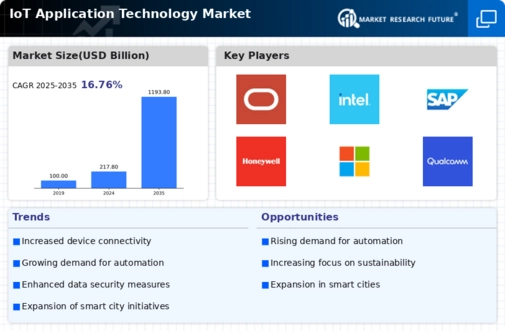Rising Demand for Smart Devices
The increasing proliferation of smart devices is a primary driver for the IoT Application Technology Market. As consumers and businesses alike adopt smart technologies, the demand for interconnected devices continues to surge. According to recent data, the number of connected devices is projected to reach 75 billion by 2025, indicating a robust growth trajectory. This trend is not limited to consumer electronics; industrial applications are also witnessing a significant uptick in smart device integration. Consequently, the IoT Application Technology Market is experiencing heightened investment and innovation to cater to this expanding ecosystem of smart devices.
Increased Focus on Data Analytics
The growing emphasis on data analytics is significantly influencing the IoT Application Technology Market. Organizations are increasingly recognizing the value of data generated by IoT devices, leading to investments in analytics tools and platforms. This trend is underscored by the fact that The IoT Application Technology is anticipated to reach USD 274 billion by 2022, with a substantial portion attributed to IoT data. By leveraging advanced analytics, businesses can derive actionable insights, optimize operations, and enhance decision-making processes. Thus, the integration of data analytics into IoT applications is a key driver for the IoT Application Technology Market.
Government Initiatives and Regulations
Government initiatives aimed at promoting IoT adoption are playing a pivotal role in shaping the IoT Application Technology Market. Various countries are implementing policies and frameworks to encourage the development and deployment of IoT technologies. For example, initiatives focused on smart cities and digital infrastructure are fostering an environment conducive to IoT growth. Additionally, regulatory frameworks addressing data privacy and security are being established to ensure safe IoT deployment. These government actions not only stimulate investment but also create a structured approach to IoT implementation, thereby driving the IoT Application Technology Market forward.
Growing Need for Operational Efficiency
The relentless pursuit of operational efficiency across industries is a significant driver for the IoT Application Technology Market. Organizations are increasingly adopting IoT solutions to streamline processes, reduce costs, and enhance productivity. For instance, in manufacturing, IoT applications enable real-time monitoring of equipment, leading to predictive maintenance and reduced downtime. This trend is reflected in the fact that companies implementing IoT solutions report an average increase of 20% in operational efficiency. As businesses continue to seek innovative ways to optimize their operations, the demand for IoT technologies is expected to rise, further propelling the IoT Application Technology Market.
Advancements in Connectivity Technologies
The evolution of connectivity technologies, such as 5G and LPWAN, is propelling the IoT Application Technology Market forward. These advancements facilitate faster data transmission and improved network reliability, which are crucial for the seamless operation of IoT applications. For instance, 5G technology is expected to enhance the performance of IoT devices by providing lower latency and higher bandwidth. This is particularly relevant for sectors like healthcare and automotive, where real-time data processing is essential. As connectivity solutions continue to improve, the IoT Application Technology Market is likely to witness accelerated adoption across various sectors.

















Leave a Comment